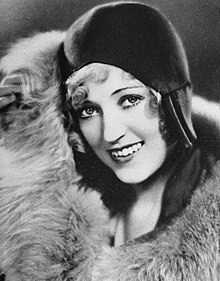
Back Marion Davies Afrikaans ماريون ديفيز Arabic ماريون ديفيز ARZ Marion Davies AST ماریون دیویس AZB Marion Davies Catalan Marion Davies German Marion Davies Spanish Marion Davies Basque ماریون دیویس Persian
Marion Davies | |
|---|---|
 Davies in the 1920s | |
| Born | Marion Cecilia Douras[a] January 3, 1897 Brooklyn, New York, U.S. |
| Died | September 22, 1961 (aged 64) Los Angeles, California, U.S. |
| Resting place | Hollywood Forever Cemetery |
| Occupations |
|
| Years active | 1914–1937 |
| Spouse |
Horace G. Brown (m. 1951) |
| Partner | William Randolph Hearst (1917–1951, his death) |
| Children | Patricia Lake (acknowledged at Lake's death) |
| Relatives | Rosemary Davies (sister) Reine Davies (sister) Charles Lederer (nephew) Pepi Lederer (niece) |
Marion Davies (born Marion Cecilia Douras;[a] January 3, 1897 – September 22, 1961) was an American actress, producer, screenwriter, and philanthropist. Educated in a religious convent, Davies fled the school to pursue a career as a chorus girl. As a teenager, she appeared in several Broadway musicals and one film, Runaway Romany (1917). She soon became a featured performer in the Ziegfeld Follies. While performing in the 1916 Follies, the nineteen-year-old Marion met the fifty-three-year-old newspaper tycoon, William Randolph Hearst, and became his mistress. Hearst took over management of Davies' career and promoted her as a film actress.[1][2]
Hearst financed Davies’ pictures and promoted her career extensively in his newspapers and Hearst newsreels. He founded Cosmopolitan Pictures to produce her films. By 1924, Davies was the number one female box office star in Hollywood because of the popularity of When Knighthood Was in Flower and Little Old New York, which were among the biggest box-office hits of their respective years.[3] During the zenith of the Jazz Age, Davies became renowned as the hostess of lavish soirees for Hollywood actors and political elites. However, in 1924, her name became linked with scandal when film producer Thomas Ince died at a party aboard Hearst's yacht.[4][5][6]
Following the decline of her film career during the Great Depression, Davies struggled with alcoholism.[7] She retired from the screen in 1937 to devote herself to an ailing Hearst and charitable work.[1] In Hearst's declining years, Davies remained his steadfast companion until his death in 1951.[8] Eleven weeks after Hearst's death, she married sea captain Horace Brown.[9] Their marriage lasted until Davies' death at 64 from malignant osteomyelitis (bone cancer) of the jaw in 1961.[10]
By the time of her death, her popular association with the character of Susan Alexander Kane in the film Citizen Kane (1941) already overshadowed Davies' legacy as a talented actress.[11] The title character's second wife—an untalented singer whom he tries to promote—was widely assumed to be based upon Davies.[1] However, many commentators, including writer-director Orson Welles, defended Davies' record as a gifted actress and comedienne to whom Hearst's patronage did more harm than good.[12] In his final years, Welles attempted to correct the widespread misconceptions the film had created about Davies' popularity and talents as an actress.[12][13]
Cite error: There are <ref group=lower-alpha> tags or {{efn}} templates on this page, but the references will not show without a {{reflist|group=lower-alpha}} template or {{notelist}} template (see the help page).
- ^ a b c Cite error: The named reference
The New York Times 1961 p. 19was invoked but never defined (see the help page). - ^ Tri-City Herald 1961, p. 2
- ^ Cite error: The named reference
Lorusso 2017 p. 96was invoked but never defined (see the help page). - ^ Cite error: The named reference
Swanberg 1961 pp. 445–46was invoked but never defined (see the help page). - ^ Elley 2001
- ^ Cite error: The named reference
Taves 2012 pp. 3–7was invoked but never defined (see the help page). - ^ Brooks 1982, p. 41
- ^ Spokane Daily Chronicle 1951, p. 7
- ^ The New York Times 1951, p. 30
- ^ Guiles 1972, p. 372
- ^ Guiles 1972, p. 91
- ^ a b Cite error: The named reference
Welles 1975 Forewordwas invoked but never defined (see the help page). - ^ Welles & Bogdanovich 1992